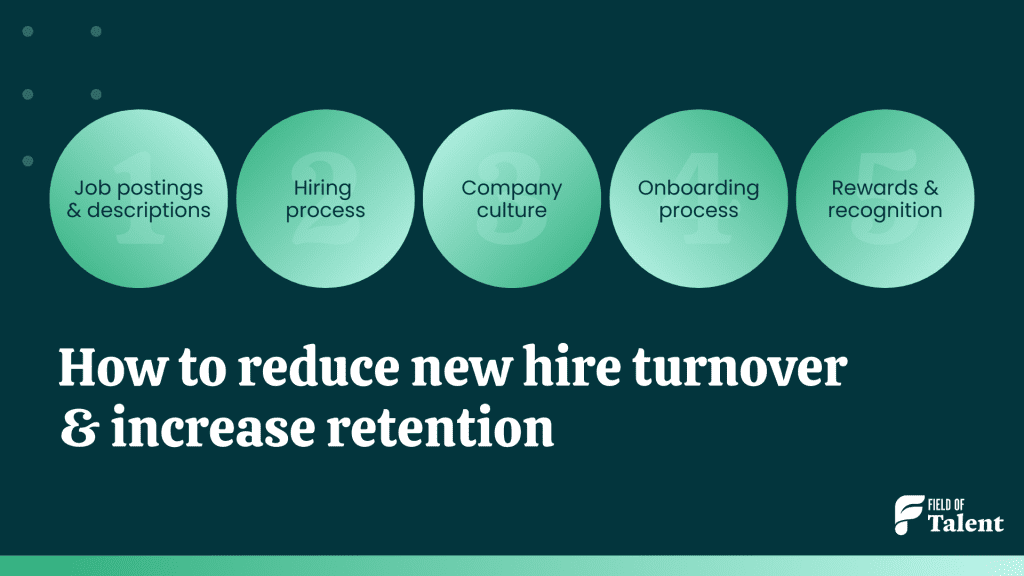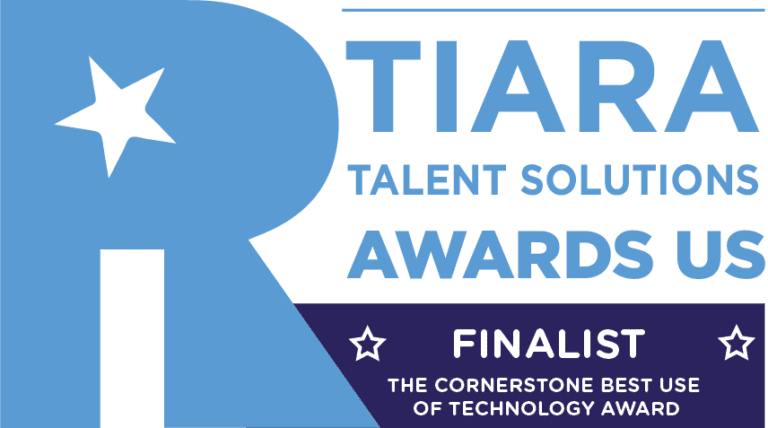More than half of employees who’ve found a new job in the last six months are already considering quitting.
The Great Resignation is real. And so is high turnover rate for new hires.
Field of Talent talks a lot about providing a best-in-class recruitment process and candidate experience. But if your top talent turns over quickly after being hired, it’s all for naught.
Erika Duncan is the co-founder of People on Point, strategic HR advisors who work with CHROs and operational leaders to drive organizational growth through innovative approaches to talent acquisition, compensation, and organizational design. Labor is the largest cost for most organizations. People on Point helps leaders drive costs down while increasing effectiveness.
As a former Chief People Officer in various health care organizations and a friend of Field of Talent, Erika shares her unique perspective on hiring and employee retention.

Why does new hire turnover matter?
During the Great Resignation, turnover rates are at all-time highs. Therefore, it’s crucial companies work hard to retain top talent and keep them in the boat. Retention rate can make or break your performance. Why?
Hiring again and again is expensive
New hire turnover rate matters because your organization doesn’t want to be in a perpetual state of recruiting the same positions. If turnover is or is becoming a problem, your cost of vacancy will also climb. Anticipate your needs before they happen, and reduce recruiting costs by making sure recruiters and hiring managers are aligned on the job requirements and the job market, set service level agreements for the hiring process, and eliminate process friction points to speed up the hiring process. Process cycle times (time to engage, time to Offer and time to offer accept) are your north star.
Erika also points out it’s critical that employers connect recruitment to their organization’s performance and health. One way to value the “current team” and therefore increase employee retention is by onboarding the right candidate with the right skills at the right time. A great new hire immediately adds value to your systems and is aligned to your mission and outcomes. Prioritizing this will increase retention of current employees.
Preventing high turnover
Do you have an employee retention strategy or feedback loop in place for your hiring process? A common reason an organization suffers employee turnover is lack of assessment after-the-fact.
At least every quarter, recruitment teams, people leaders and executives should be asking:
- What are common sources of hiring?
- Who is turning over?
- Why are they leaving?
- How do we collect feedback on hiring and onboarding?
- What can we do to make it hard for someone to leave?
This feedback loop will give your team insight on the past and foresight on the future. Go deeper in your analysis to find the root causes of trouble, double down on things that work, and avoid things that aren’t.
New hire retention is vital to your organization’s performance. Here are seven ways to reduce your high turnover rate during both the hiring process and onboarding.
How to reduce new hire turnover & increase retention
Before jumping into her strategies to reduce employee turnover and strengthen new hire retention, Erika advises these tactics are industry- and size-agnostic but are culture-dependent.
Company culture exists on a spectrum between high-touch and high-tech. It’s difficult, therefore, to create a culture of both extreme compassion and advanced technology.
- High-touch: Do you have the people resources to be incredibly compassionate?
- High-tech: Do you have the tech capability to use cutting edge tools?
Your reward programs, communication style, well-being strategy – everything! – likely fall in line with your organization’s culture style.
Keep your company culture in mind as you read Erika’s suggestions on decreasing your turnover rate, and implementing them in your employee retention strategy. What will resonate with your people?

1. Improve your job postings & job descriptions
The start of any great recruitment process, candidate experience, and employer-employee relationship is a well-written job posting. Without a clear picture of what life looks like in the job, active job seekers can’t fully understand your opportunity. Also, candidates may wear rose-colored glasses during your interview process, be blindsided when they start work, and quickly realize they don’t belong. Job descriptions can set the right expectations from the get-go.
Hiring managers often underestimate the power of clear, concise job descriptions in favor of “just getting it up.” The hiring process can’t get off the ground if you’re not attracting top talent to your application.
Get more tips for creating a stellar job posting that attracts the right target market to your company.
2. Improve your hiring process
Just as with a clear job description, a quick and confident hiring process will kickstart a great employee experience. When they feel respected, challenged and a sense of belonging during interviews, candidates are likely to accept your offer.
Erika says most employers must change their perspective on hiring during the Great Resignation because job candidates control the market, not vice versa. Therefore, your talent acquisition strategy has to be aggressive and fast.
Recruitment process speed is far more important to an effective employer-employee relationship than most hiring managers think. 96% of candidates accept the first offer they’re given. So if you can speed up your process just by a few days, you can potentially get every top draft pick you need to grow your company.
Need to reduce inefficiencies in your hiring process? Check out these expert tips.
3. Connect your company culture
In 2018 a Gallup study found only two in ten U.S. workers had a best friend at work. And when someone was close with a colleague, the company received 7% more engagement and 12% more profit.
“Buzzwords are buzzwords for a reason.” Erika reiterates retention is higher when employees have a real connection with their employer and organization. Create a workplace that’s more about your culture and people than the paycheck, and your top talent will struggle to leave.
Help your employees connect better with your team:
- Be intentional about engagement and belonging
- Balance recruitment and retention financially
- Implement an integration system during onboarding (Ask yourself, ”How do I tether someone with people, processes, and outcomes?”)
During the hiring process, organizations who know their mission and values find it easier to spot personalities that fit their culture. Remember your company’s purpose when recruiting your next hire.
4. Plan onboarding process & programs
Employee onboarding is critical to reducing your turnover rate. A recent study found that an effective onboarding process and experience can improve employee retention by 82%. Yet, a measly 12% of employers onboard well.
That dichotomy spells disaster.
But onboarding itself isn’t necessarily enough. Your new hires need to assimilate to your culture and feel a sense of belonging to your wider organization, no matter your size. With whom does your candidate have a solid connection? Build off of that relationship with a structured, formal mentor system.
One way to improve your onboarding process is with feedback. Because your new hires just experienced it, they have a fresh perspective and certainly many thoughts and emotions. The Candidate Experience Awards found soliciting new hire feedback improves your employer-employee relationship by 91%. Your top talent starts off on the strongest foot possible.
And when your employee experience is strong, so is recruitment.
5. Reward & recognize your new hires
Finally, Erika recommends that organizations reward and recognize their employees instantly and frequently. To some workers, they appreciate gift boxes, swag, and a corner office. To others, it’s frequent meetings with leadership, consistent feedback, and public displays of gratitude. Personalize the employee experience for each employee.
For at least the first six months, Erika says, companies should make an intentional effort to connect with new hires. “You’d be surprised by how many organizations don’t just ask how their employees would like to be rewarded and recognized.”
Gamifying retention makes feedback loops more fun. She recommends Skillsurvey as a tool to retain new hires. Their platform offers solutions for the candidate and employee experiences:
- Reference checking
- Automated feedback loops
- Onboarding surveys
- Engagement surveys
- Exit surveys
Engagement & retention in the age of remote work
In the end, retention comes down to making a genuine connection with your new hires. Erika adds with the advent of remote and hybrid work, employers must be more intentional and authentic about their touchpoints. When employees aren’t able to physically see each other in the office every day, focus emphasize a high-touch versus high-tech culture. Asynchronous communication tools like email and Slack make deep connection difficult. So keep the cadence real and frequent.
Your expertise in all things new hire retention are desperately needed during the Great Resignation to reduce employee turnover and improve the employee experience in your organization. Once you’ve done that, you’re on your way to improved performance and a better bottom line.
Special thank you to HR expert Erika Duncan from People on Point. Their expertise, especially during mergers and acquisitions, is incredibly valuable for any organization. Need to retain your top talent through this downturn? Get a free 30-minute advisory call here.


